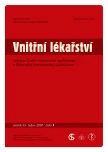Epilepsy and disorders of reproduction
Authors:
I. Dravecká; I. Lazúrová
Authors‘ workplace:
I. interná klinika Lekárskej fakulty UPJŠ a FN L. Pasteura, Košice, Slovenská republika, prednosta prof. MUDr. Ivica Lazúrová, CSc.
Published in:
Vnitř Lék 2007; 53(1): 46-53
Category:
Reviews
Overview
Epilepsy in women is relatively often linked with reproductive disorders which include polycystic ovarian syndrome, hypothalamic amenorrhea and functional hyperprolactinaemia. These disorders have a significant share in a high incidence of infertility and premature menopause while the polycystic ovarian syndrome, also manifested by the metabolic syndrome, places the affected patients at risk of later consequences such as type 2 diabetes mellitus, cardiovascular diseases including arterial hypertension, gynaecological neoplasias (the breast and the endometrium), and in the case of pregnancy, a higher incidence of pregnancy induced hypertension. Apart from epilepsy as such, also antiepileptic treatment may have negative impact on the female’s reproductive functions. In many cases, adverse effects of treatment complicate the patient’s life more than the attacks alone. Medication induced weight gain might be responsible for different endocrine diseases (menstruation disorders, polycystic ovarian syndrome, hyperandrogenism). The article analyses the influence of side effects of the different antiepileptic drugs on the development of metabolic and endocrine anomalies. The role of antiepileptic drugs in the development of reproductive and endocrine disorders was first described by Isojärvim in 1993. A high incidence of polycystic ovarian syndrome and/or hyperandrogenism (43 %) was observed in women taking valproat, which was clearly higher than in women taking other antiepileptics. Results reported in literature are rather controversial. The article gives an overview of current knowledge with respect to the influence of epilepsy and antiepileptics on the incidence of polycystic ovarian syndrome, which is considerably higher in women with epilepsy (10–25 %) than in the unaffected population (4–7 %), and of the related metabolic syndrome. The article concludes with recommendations for clinical practice in the treatment of epilepsy in women in reproductive age.
Key words:
epilepsy – polycystic ovarian syndrome – metabolic syndrome – antiepileptics
Sources
1. Morrel MJ, Giudice L, Flynn L et al. Predictive factors of ovarian dysfunction in women with epilepsy. Ann Neurol 2002; 52: 704-711.
2. Biton V, Mirza W, Montouris G et al. The change of body weight in valproate and lamotrigine therapy in patients with epilepsy. Neurology 2001; 56: 172-177.
3. Isorjävi JIT. Reproductive dysfunction in women with epilepsy. Neurology 2003; 61: 27-34.
4. Meo R, Bilo L. Polycystic ovary syndrome and epilepsy. Drugs 2003; 63: 1185-1227.
5. Franks S. Polycystic ovary syndrome. N Engl J Med 1995; 333: 853-861.
6. Ragon N. The relationship between polycystic ovary syndrome and antiepileptic drugs. J Clin Psychopharmacol 2004; 24: 322-334.
7. Bilo L, Meo R, Valentino R et al. Charcterization of reproductive endocrine disorders in women with epilepsy. JCE & M 2001; 86: 2950-2956.
8. Polson D. Polycystic ovary syndrome and epilepsy - a gynaecological perspective. Seizure 2003; 12: 397-402.
9. Herzog AG, Seibel MM, Schomer D et al. Temporal lobe epilepsy: an extrahypothalamic pathogenesis for polycystic ovary syndrome? Neurology 1984; 34: 1389-1393.
10. Bilo L, Meo R, Nappi C et al. Reproductive endocrine disorders in women with primary generalized epilepsy. Epilepsia 1988; 29: 612-619.
11. Bilo L, Meo R, Valentino R et al. Abnormal pattern of luteinizing hormone pulsatility in women with epilepsy. Fertil Steril 1991; 55: 705-711.
12. Drislane FW, Coleman AE, Schomer DL. Altered pulsatile secretion of luteinizing hormone in women with epilepsy. Neurology 1994; 44: 306-310.
13. Ciampani M, Verrotti A, Chiarelli F. Sex hormones in patients with epilepsy - hormonal changes in epileptic men and women taking antiepileptics. Horm Metab Res 2005; 37: 184-188.
14. Rasgon N, Altshuler L, Guideman D et al. Medication status and polycystic ovary synsdrome in women with bipolar disorder: a preliminary report. J Clin Psychiatry 2000; 61: 173-178.
15. O´Donovan C, Kusumakar V, Graves G et al. Menstrual abnormalities and polycystic ovary syndrome in women taking valproate for bipola mood disorder. J Clin Psychiatry 2002; 63: 322-330.
16. Isojärvi JIT, Laatikainen TL, Pakarinen AJ et al. Polycystic ovaries and hyperandsrogenism in women taking valproate for epilepsy. N Engl J Med 1993; 329: 1383-1988.
17. Isojärvi JIT, Tauboll E, Pakarinen AJ et al. Altered ovarian function and cardiovascular risk factors in valproate-treated women. Am J Med 2001; 111: 290-296.
18. Isojärvi JIT, Laatikainen TL, Knip M et al. Obesity and endocrine disorders in women taking valproate for epilepsy. Annals of Neurology 1996; 39: 579-584.
19. Vainionpaa L, Rattya J, Knip M et al. Hyperandrogenism in girls aged 8-18 years taking valproate. Epilepsia 1998; 39: 162.
20. Stephen LJ, Kwan P, Shapiro D et al. Hormone profiles in young adults with epilepsy treated with sodium valproate or lamotrigine monotherapy. Epilepsia 2001; 42: 1002-1006.
21. Murialdo G, Galimberti CA, Gianelli MV et al. Effects of valproate, phenobarbital, and carbamazepineon sex steroid setup in women with epilepsy. Clin Neuropharmacol 1998; 21: 52-58.
22. Bauer J, Jarre A, Klingmuller D et al. Polycystic ovary syndrome in pacients with focal epilepsy: a study in 93 women. Epilepsy Res 2000; 4: 163-167.
23. Bilo L, Meo R, Valentino R et al. Characterization of reproductive endocrine disorders in women with epilepsy. J Clin Endocrinol Metab 2001; 86: 2950-2956.
24. Luef G, Abraham I, Trinka E et al. Hyperandrogenism, postprandial hyperinsulinism and the risk of PCOS in a cross sectional study of women with epilepsy treated with valproate. Epilepsy Res 2002; 48: 91-102.
25. Herzog AG. Menstrual disorders in women epilepsy. Neurology 2006; 66 (Suppl 3): 23-28.
26. Hill M. Reprodukční a endokrinní poruchy. EpiStop - Žena a epilepsie. Praha: Maxdorf 2004: 40-49.
Labels
Diabetology Endocrinology Internal medicineArticle was published in
Internal Medicine

2007 Issue 1
Most read in this issue
- The FEVER (Felodipine EVEnt Reduction) trial; a randomised, double-blind, placebo-controlled trial in Chinese hypertensive patients
- Guidelines for pharmacotherapy of acute and chronic non-oncological pain
- The importance of determination of Nt-proBNP and big endothelin in diagnosing chronic heart failure in patients on regular haemodialysis treatment
- Epilepsy and disorders of reproduction
